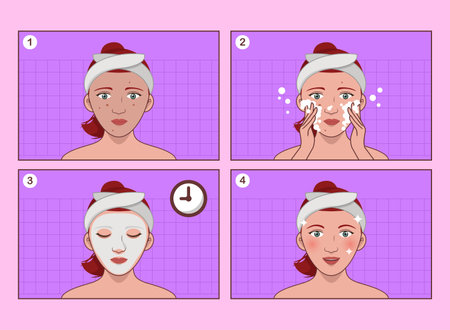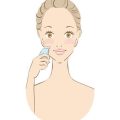Introduction: The Rise of Facial Cleansing Brushes in the UK
In recent years, facial cleansing brushes have become a staple in the beauty routines of many British skincare enthusiasts. With an increasing focus on self-care and skin health, these innovative devices have caught the attention of those looking to elevate their daily cleansing ritual. But what exactly is driving this surge in popularity across the UK? More than just a passing trend, facial cleansing brushes are being lauded for their ability to provide a deeper, more thorough cleanse compared to traditional methods. From London’s high street shops to online beauty forums, conversations around these tools have highlighted their effectiveness in removing impurities, exfoliating gently, and supporting a radiant complexion. Their rise can also be attributed to advances in technology and the growing accessibility of expert skincare advice. As more Britons seek professional-level results from the comfort of home, cleansing brushes have swiftly moved from luxury items to everyday essentials.
2. How Facial Cleansing Brushes Work: An Easy Science Breakdown
Facial cleansing brushes have become a staple in many UK skincare routines, but understanding how these devices work can help you make the most of them while caring for your delicate skin barrier. At their core, facial cleansing brushes use either gentle rotating or sonic (vibrating) technology to provide a more thorough cleanse than manual washing alone. By carefully dislodging dirt, oil, and makeup from the pores, these brushes aim to leave your complexion feeling refreshed and radiant.
The Technology Behind Cleansing Brushes
Most devices on the market today use one of two main mechanisms:
| Type | How It Works | Key Benefits |
|---|---|---|
| Rotating Brush Heads | Bristles rotate in circular motions to sweep away impurities. | Gently exfoliates, helps remove stubborn debris. |
| Sonic Vibrations | High-frequency vibrations loosen and lift particles from the skin surface without harsh scrubbing. | Minimises irritation, maintains skin’s softness. |
Interacting with the Skin’s Natural Barrier
Your skin barrier—the outermost layer—acts as a shield against environmental aggressors and locks in moisture. It’s important that any cleansing device respects this barrier. Quality facial cleansing brushes are designed with ultra-soft bristles or silicone touchpoints to reduce friction and avoid microtears. UK dermatologists highlight that when used correctly (no excessive pressure or prolonged use), these brushes can enhance your routine without compromising your skin’s natural defences.
Supporting Healthy Skin Function
Regular but gentle use can promote better absorption of serums and moisturisers by clearing away dead cells and buildup. However, those with sensitive or compromised skin should opt for softer brush heads and always follow up with hydrating products suitable for the UK’s often chilly and damp climate.
Summary Table: Skin Barrier & Brush Interaction
| Aspect | Cleansing Brush Impact | Recommended Approach (UK) |
|---|---|---|
| Exfoliation | Mildly increases cell turnover when used moderately. | Use 1-2 times per week for normal skin; less frequently for sensitive types. |
| Moisture Retention | No significant disruption if brush is gentle. | Pair with rich moisturisers especially during colder months. |
| Irritation Risk | Poor technique may cause redness or sensitivity. | Select soft bristles/silicone; avoid overuse; monitor skin response. |
This scientific yet gentle approach means you can enjoy the benefits of facial cleansing brushes while maintaining the health and resilience of your British complexion.

3. Expert Insight: What UK Dermatologists Say
When it comes to facial cleansing brushes, UK dermatologists offer a balanced perspective rooted in science and practical experience. While many appreciate the potential benefits of these devices, such as improved exfoliation and more thorough cleansing, they also urge users to approach with care and mindfulness. Below, we outline current recommendations, cautionary notes, and key considerations frequently shared by skincare professionals across the country.
Current Recommendations
| Recommendation | Details |
|---|---|
| Frequency of Use | Most dermatologists recommend using cleansing brushes 2-3 times a week for normal skin. Those with sensitive or dry skin should use them less frequently to avoid over-exfoliation. |
| Brush Selection | Soft-bristled, gentle brushes are preferred. Avoid harsh or abrasive options that can damage the skin barrier. |
| Cleansing Products | Pair your brush with a mild, fragrance-free cleanser to minimise irritation and support skin health. |
Cautionary Notes
- If you have active acne, rosacea, eczema, or other inflammatory conditions, consult a dermatologist before introducing a cleansing brush to your routine.
- Overuse may lead to increased sensitivity, redness, or microtears in the skin—less is often more when it comes to mechanical exfoliation.
- Always keep your device clean by washing the brush head regularly and replacing it as recommended by the manufacturer to prevent bacterial build-up.
Key Considerations for UK Consumers
- Climate and Environment: The UKs variable weather can impact skin hydration levels. In colder months, limit brush use to avoid exacerbating dryness.
- Skin Type: Tailor usage based on whether your skin is oily, dry, combination, or sensitive for best results and minimal risk.
- Lifestyle Factors: City dwellers exposed to pollution may benefit from occasional deeper cleansing but should still proceed with caution.
A Gentle Reminder from Dermatologists
The consensus among UK experts is clear: while facial cleansing brushes can be a valuable addition to your skincare regime, they must be used thoughtfully and in harmony with your individual needs. Always listen to your skin’s response and seek professional advice if you’re unsure how best to incorporate these tools into your daily routine.
4. Suitability for Different British Skin Types
The unique British climate, with its frequent rain, fluctuating temperatures, and urban pollution, can pose specific challenges for our skin. UK dermatologists emphasise that facial cleansing brushes may offer benefits, but their suitability depends on individual skin types and concerns commonly found across the UK. Understanding how your skin responds to both the climate and this popular tool is key to maintaining a healthy complexion.
Common British Skin Types and Typical Concerns
| Skin Type | Common Concerns in the UK | Recommended Brush Use |
|---|---|---|
| Sensitive | Redness, irritation due to cold winds and pollution | Opt for ultra-soft bristles; use 1-2 times per week only |
| Oily/Combination | Shine, enlarged pores, congestion from humidity and city air | Use soft or medium bristles; cleanse up to 3 times per week |
| Dry/Mature | Tightness, flakiness, increased by central heating and cold snaps | Choose gentle brush heads; limit to weekly use; always follow with hydrating care |
| Normal/Balanced | Occasional dullness from lack of sun exposure or stress | Moderate use (2-3 times weekly); monitor for any sensitivity changes seasonally |
The Importance of Personalisation and Seasonal Adjustments
Your skin’s needs are not static: UK dermatologists recommend adjusting your cleansing routine as the seasons change. For example, winter may require extra gentleness, while summer might allow slightly more frequent use due to increased oiliness or pollution exposure. Always listen to your skin—redness, tightness, or stinging are signs to reduce frequency or switch brush heads.
A Word on Specific Conditions: Rosacea & Eczema
If you experience conditions such as rosacea or eczema—both relatively prevalent in the UK—it’s best to consult your dermatologist before introducing a cleansing brush. These tools can sometimes exacerbate sensitivity if not chosen and used carefully.
Nurturing Your British Skin Gently
No matter your skin type, pairing your facial cleansing brush with a gentle cleanser and always following up with moisturiser will help support your skin barrier against the elements. Remember: less is often more when it comes to mechanical exfoliation in our British climate.
5. Best Practices for Gentle and Effective Use
Integrating a facial cleansing brush into your daily skincare routine can be a wonderful way to achieve a deeper cleanse, but it’s important to follow some simple, dermatologist-approved tips to avoid irritation—especially if you have sensitive or reactive British skin. Here are the essentials every UK skincare enthusiast should keep in mind:
Choose the Right Brush and Cleanser
Opt for a cleansing brush with soft bristles and gentle settings. Pair it with a mild, fragrance-free cleanser suitable for your skin type. Avoid harsh scrubs or active ingredients like retinoids during use.
Recommended Frequency of Use
| Skin Type | Recommended Frequency |
|---|---|
| Sensitive/Dry | 1-2 times per week |
| Normal/Combination | 2-3 times per week |
| Oily/Resilient | Up to 4 times per week |
Step-by-Step Application Tips
- Dampen both your face and the brush head with lukewarm water—never hot, as this can strip the skin’s natural oils.
- Apply a small amount of cleanser to either the brush or your skin.
- Use light pressure and move the brush in gentle, circular motions for no more than 60 seconds, focusing on areas prone to congestion.
- Avoid delicate areas such as the eyes and lips.
- Rinse thoroughly and pat dry with a clean, soft towel.
Caring for Your Cleansing Brush
UK dermatologists emphasise the importance of hygiene: rinse your brush head after every use and allow it to air dry completely. Replace brush heads every three months to prevent bacterial build-up.
Top Tips from UK Dermatologists
- If irritation occurs, reduce usage frequency or pause until your skin recovers.
- Always follow up with a hydrating moisturiser to soothe and protect your skin barrier, especially during colder British weather.
- Avoid sharing your cleansing brush to minimise cross-contamination.
By following these best practices, you can enjoy the benefits of facial cleansing brushes without compromising your skin’s health—keeping your complexion radiant and comfortable all year round in the UK climate.
6. Common Myths: Separating Facts from Fiction
Facial cleansing brushes have become a staple in many UK skincare routines, but with their popularity comes a host of myths and misconceptions. Understanding the science behind these devices is essential for making informed choices about your skincare regimen. Here, we address some of the most common concerns voiced by British consumers, from fears of over-exfoliation to questions about device hygiene.
Myth vs Fact: What You Need to Know
| Myth | Fact |
|---|---|
| Using a facial brush daily will damage my skin. | UK dermatologists agree that, when used as directed (typically 2-3 times per week), most modern brushes are designed to be gentle on the skin, especially those with soft bristles. |
| Cleansing brushes cause breakouts. | Breakouts can occur if the brush isn’t cleaned regularly. Proper hygiene and replacing brush heads as recommended helps maintain skin health. |
| These devices are too harsh for sensitive British skin types. | Many brands now offer brushes with varying settings and ultra-soft bristles suitable for sensitive or reactive skin. Always patch test first and consult a dermatologist if unsure. |
| Cleansing brushes replace the need for professional treatments. | While effective at enhancing daily cleansing, they don’t substitute professional facials or dermatological care for specific conditions like acne or eczema. |
Addressing Over-Exfoliation Concerns
One prevalent worry in the UK is that facial cleansing brushes may lead to over-exfoliation, leaving skin irritated or stripped. However, experts stress that over-exfoliation typically results from using abrasive cleansers or combining too many exfoliating products. By following manufacturer guidelines and listening to your skin’s needs, you can enjoy smoother, brighter skin without compromising its natural barrier.
Keeping Your Device Clean
Hygiene is paramount—especially in Britain’s often damp climate. Dermatologists recommend rinsing brush heads thoroughly after each use, letting them air dry completely, and replacing them every three months. Some models even come with antimicrobial technology for extra peace of mind. Remember: clean tools mean healthier skin.
By separating fact from fiction and paying attention to expert advice, you can harness the benefits of facial cleansing brushes while safeguarding your complexion—leaving your skin fresh, radiant, and well cared for in true British style.


